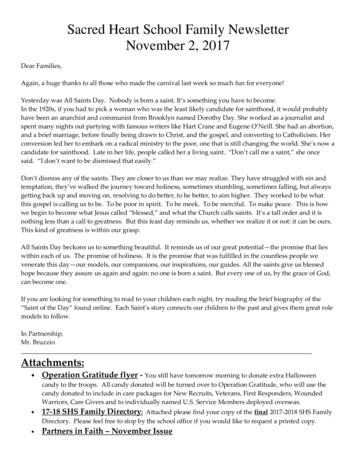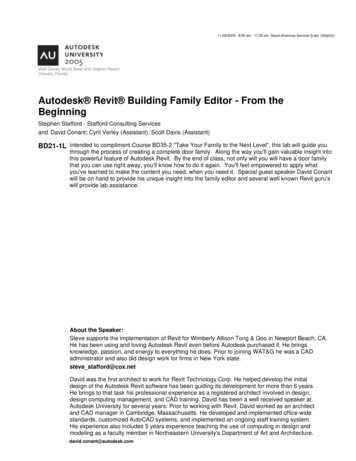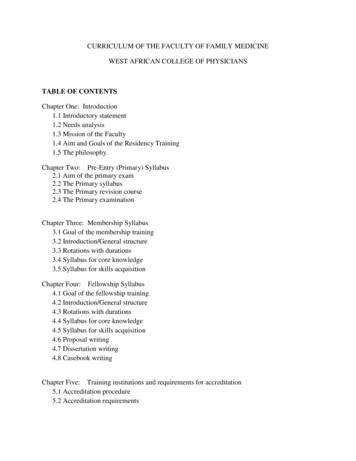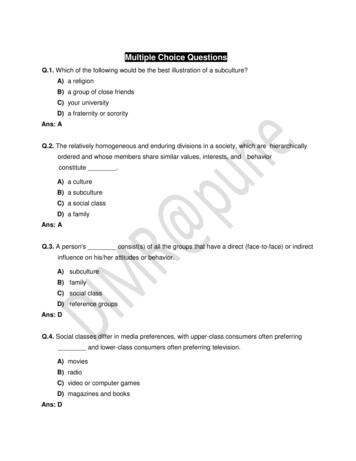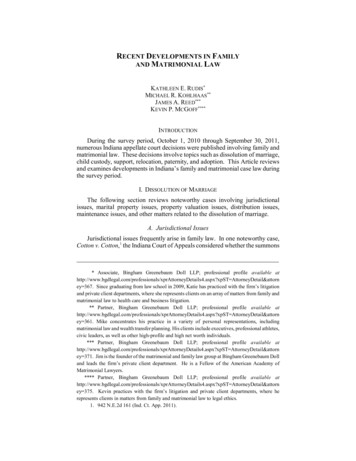
Transcription
RECENT DEVELOPMENTS IN FAMILYAND MATRIMONIAL LAWKATHLEEN E. RUDIS*MICHAEL R. KOHLHAAS**JAMES A. REED***KEVIN P. MCGOFF****INTRODUCTIONDuring the survey period, October 1, 2010 through September 30, 2011,numerous Indiana appellate court decisions were published involving family andmatrimonial law. These decisions involve topics such as dissolution of marriage,child custody, support, relocation, paternity, and adoption. This Article reviewsand examines developments in Indiana’s family and matrimonial case law duringthe survey period.I. DISSOLUTION OF MARRIAGEThe following section reviews noteworthy cases involving jurisdictionalissues, marital property issues, property valuation issues, distribution issues,maintenance issues, and other matters related to the dissolution of marriage.A. Jurisdictional IssuesJurisdictional issues frequently arise in family law. In one noteworthy case,Cotton v. Cotton,1 the Indiana Court of Appeals considered whether the summons* Associate, Bingham Greenebaum Doll LLP; professional profile available yDetails4.aspx?xpST AttorneyDetail&attorney 367. Since graduating from law school in 2009, Katie has practiced with the firm’s litigationand private client departments, where she represents clients on an array of matters from family andmatrimonial law to health care and business litigation.** Partner, Bingham Greenebaum Doll LLP; professional profile available yDetails4.aspx?xpST AttorneyDetail&attorney 361. Mike concentrates his practice in a variety of personal representations, includingmatrimonial law and wealth transfer planning. His clients include executives, professional athletes,civic leaders, as well as other high-profile and high net worth individuals.*** Partner, Bingham Greenebaum Doll LLP; professional profile available yDetails4.aspx?xpST AttorneyDetail&attorney 371. Jim is the founder of the matrimonial and family law group at Bingham Greenebaum Dolland leads the firm’s private client department. He is a Fellow of the American Academy ofMatrimonial Lawyers.**** Partner, Bingham Greenebaum Doll LLP; professional profile available yDetails4.aspx?xpST AttorneyDetail&attorney 375. Kevin practices with the firm’s litigation and private client departments, where herepresents clients in matters from family and matrimonial law to legal ethics.1. 942 N.E.2d 161 (Ind. Ct. App. 2011).
1184INDIANA LAW REVIEW[Vol. 45:1183served with a petition for dissolution of marriage must include a clear statementof the risk of default for failure to appear or otherwise respond.In Cotton, the husband and wife married in 2002.2 In March 2009, thehusband filed a petition for dissolution of marriage. The wife was served with asummons and copy of the petition, but she failed to appear and did not respondto the petition.3 At the final hearing in September 2009, the wife did not appearand she received no notice of the final hearing.4 The trial court defaulted the wifeand entered a final dissolution decree awarding joint legal and physical custodyof the parties’ son.5 The wife appealed this ruling.On appeal, the wife contended that the decree was void because it wasentered without personal jurisdiction over her, due to insufficiency of process;specifically, the summons used by the husband did not include languagearticulating a risk of default for doing nothing.6 In reviewing the summons, thecourt of appeals concluded: “We hold that due process requires that, at aminimum, a respondent in a dissolution proceeding be notified of the risk ofdefault for failure to appear or otherwise respond.”7 The court of appeals added,“[T]he command of Trial Rule 4(C)(5), grounded in due process, is that therespondent in a dissolution proceeding must be given notice in a ‘clear statement’of the risk of default for failure to appear or other respond.”8 Concluding that thesubject summons did not comply with Trial Rule 4(C)(5), or the Due ProcessClause, the dissolution decree was reversed and remanded for furtherproceedings.9B. Property DistributionDistributing marital property raises issues involving how to define the maritalestate, how to value marital property, and how to distribute marital property.1. Defining the Marital Estate.—Generally, assets are subject to divisionwhen there is an immediately existing right of present enjoyment. In Ford v.Ford,10 the Indiana Court of Appeals reviewed a trial court decision consideringwhether the husband’s employer-funded health benefit account constituted amarital asset subject to division. The court also considered the value of theaccount.During dissolution proceedings between the parties in Ford, the partiesreached a mediated settlement, in which they agreed to all issues except whetherthe husband’s employer-funded health benefit account, valued at 28,694.312.3.4.5.6.7.8.9.10.Id. at 163.Id.Id. at 163-64.Id. at 163.Id. at 163-65.Id. at 165.Id.Id. at 166.953 N.E.2d 1137 (Ind. Ct. App. 2011).
2012]FAMILY AND MATRIMONIAL LAW1185constituted a divisible marital asset.11 The trial court found that the account wasa divisible marital asset.12 The trial court also found that because the parties hadagreed on a value of the account, the trial court should accept that value.13On review, the Indiana Court of Appeals found that the husband had animmediately-existing right of present enjoyment of the account, and therefore wasvested in possession with regard thererto.14 Thus, the court found that the trialcourt properly concluded that the account was a divisible marital asset.15 Thecourt did consider the contingencies that might impact the account in the future,but the court determined that the contingencies did not change the fact that thehusband had an immediately-existing right of present enjoyment of the account.16The court’s review of the valuation of the asset revealed that the partiesagreed only that “the sum of 28,694.31 was the amount of employercontributions in the [account] as of March 2010.”17 The court ruled that this wasnot the same as agreeing that the value of the account as a marital asset was 28,694.31.18 Moreover, the court found that due to the various contingenciesthat might affect the husband’s future enjoyment of the account, “the [a]ccountmight well be valued at substantially less than 28,694.31.”19The court affirmed the trial court’s conclusion that the account was a maritalasset subject to division, but reversed and remanded the trial court’s judgmentregarding valuation of the account.202. Property Valuation Issues.—Several cases during the survey periodaddressed the issue of valuing property includable in the marital estate.Specifically, the court considered valuation when the value of an asset haschanged significantly during the pendency of dissolution. In McGrath v.McGrath,21 the Indiana Court of Appeals considered the selection of a valuationdate for a marital asset, where the trial court has a choice between using a date offiling value and a date closer to the final hearing, and the value of the assetchanged significantly during the pendency due solely to market fluctuation.In McGrath, the wife filed a petition for dissolution of marriage in 2005.22Several months later, the real estate property that the couple owned in MichiganCity was appraised for 389,000.23 In late 2009, as the parties’ final hearing11.12.13.14.15.16.17.18.19.20.21.22.23.Id. at 1141.Id.Id.Id. at 1142-43.Id.Id. at 1143.Id. at 1144 (citation omitted).Id.Id.Id.948 N.E.2d 1185 (Ind. Ct. App. 2011).Id. at 1185.Id.
1186INDIANA LAW REVIEW[Vol. 45:1183approached, the property was appraised again, this time for 229,000.24In April 2010, the parties’ final hearing was held.25 Both the 2005 and 2009appraisals for the Michigan City property were admitted into evidence.26Following the final hearing, the trial court awarded the Michigan City propertyto the husband at its 2005 valuation, which the husband argued reduced his shareof the marital property to less than fifty percent.27The court of appeals noted the general axioms that the trial court has broaddiscretion in determining the date on which marital assets should be valued.28Further, “for purposes of choosing a date upon which to value marital assets, thetrial court may select any date of filing between the date of filing the petition fordissolution and the date of the final hearing.”29 Nevertheless, the court of appealsconcluded that “the court abused its discretion in failing to consider thesubstantial change in value of the [Michigan City real estate] as expressed in the2009 appraisal report.”30 The trial court’s decree was reversed and remandedwith instructions to take into account the decline in the value of the MichiganCity real estate.31Additionally, during the survey period, the Indiana Court of Appeals issuedcase law regarding supplemental property settlement payments. The courtdetermined that when more than one property was at issue, the properties mustbe viewed collectively for purposes of equalization payments.323. Distribution Issues.—Cases regarding distribution issues can arise whena party to dissolution believes their spouse dissipated assets, when eventssubsequent to dissolution complicate future retirement distribution, or when aproperty settlement agreement requires clarification. The court has determinedthat awarding one party more than 100% of the marital estate is an abuse ofdiscretion, absent a finding of dissipation. In Smith v. Smith,33 the Indiana Courtof Appeals considered whether the trial court abused its discretion in awardingone party more than 100% of the marital estate, absent a finding of dissipationthat supported the award.24. Id.25. Id.26. Id. at 1188.27. Id. at 1185-87.28. Id. at 1187 (citing Wilson v. Wilson, 732 N.E.2d 841, 845 (Ind. Ct. App. 2000)).29. Id. (citing Wilson, 732 N.E.2d at 845).30. Id. at 1189.31. Id. Judge Friedlander concurred with a separate opinion, stressing the inconsistenciespresent in the trial court’s decree. Id. (Friedlander, J., concurring).32. See Connolly v. Connolly, 952 N.E.2d 203, 207-08 (Ind. Ct. App. 2011) (“[I]n the eventof a post-dissolution increase in value of husband’s ownership interest in [the property], [w]ifewould be entitled to an ‘equalization payment’ based upon an increase in the value of that interest. . . it is not disputed that [h]usband’s ownership interest in [the property] decreased. Accordingly,wife is not entitled to an equalization payment based on [h]usband’s ownership interest (alterationomitted) (citation omitted)).33. 938 N.E.2d 857 (Ind. Ct. App. 2010).
2012]FAMILY AND MATRIMONIAL LAW1187In Smith, the only contested issue for the divorce proceeding was the divisionof marital assets.34 The parties had assets of about 46,000 and debts of about 39,000, making the value of the marital estate about 7,000.35 The husbandearned, or was capable of earning 1,310 per week and the wife earned, or wascapable of earning 686. The trial court found that the wife rebutted thepresumption of an equal division of the marital estate due to the earning abilitiesof the parties.36 The wife’s net award by the trial court was around 11,500 andthe husband’s was around (- 4,500).37 The husband subsequently appealed.38On appeal, the husband argued that the trial court abused its discretion byawarding the wife more than one-hundred percent of the net marital estate.39 Thecourt of appeals agreed with the husband, noting that “[a]bsent a finding ofdissipation of assets, a property division cannot exceed the value of the maritalassets without being considered an improper form of maintenance and an abuseof discretion.”40 The court reversed and remanded to the trial court for areasonable division of the marital estate not to exceed the net value of the maritalestate.41Although this opinion cites the 1999 Pitman42 case, its dicta reveals animportant distinction between the two cases. Pitman stands for the propositionthat, even when dissipation occurs, the divorce court may not divide the maritalestate as though the dissipated asset remains fictionally part of the marital estate.43Further, Pitman notes that, where the remaining, non-dissipated marital propertyis insufficient to make the non-dissipating party whole, even after receiving onehundred percent of the remaining marital estate, the aggrieved party’s onlyremedy is to seek a rescission of the transaction that resulted in the dissipation.44By contrast, the Smith court implies that, with a finding of dissipation, anaward of more than one-hundred percent of the marital estate to the nondissipating party may be proper.45 In that regard, Smith appears to reverse aportion of the Pitman holding. In Pitman, the court of appeals found the trialcourt erred in awarding a money judgment to the wife to compensate her for stockthat the husband dissipated through a transfer to family members as part ofdivorce planning.46 Under Smith, that finding of dissipation would seem tosupport the overall division of the marital estate undertaken by the Pitman trial34.35.36.37.38.39.40.41.42.43.44.45.46.Id. at 859.Id.Id.Id.Id. at 860.Id.Id. at 861.Id.Pitman v. Pitman, 721 N.E.2d 260 (Ind. Ct. App. 1999).See id. at 267.Id.See Smith, 938 N.E.2d at 861.Pitman, 721 N.E.2d at 267.
1188INDIANA LAW REVIEW[Vol. 45:1183court.In another case during the survey term, Bandini v. Bandini,47 the court alsoaddressed the restructuring of benefits so as to decrease divisible retirementbenefits. In Bandini, the Indiana Court of Appeals reviewed a trial court decisionconsidering whether the husband violated the dissolution decree when, after thedivorce, he restructured his military benefits so as to reduce his monthlyretirement benefit (that was being shared with the wife) in an effort to acquire anincrease in new disability benefits (which the husband did not have to share withthe wife).In this case, the husband and wife married in 1971.48 The husband was in theArmy and Army Reserve until 1995.49 The parties divorced in 2005.50 Theproperty settlement agreement that was incorporated into their decree providedthat the “[w]ife shall have . . . (50%) of [h]usband’s USAR militaryretirement/pension plan by QDRO, including survivor benefits.”51 The husbandturned sixty in 2008 and began receiving retirement benefits.52 The governmentdivided each monthly payment so that the husband and wife each receivedapproximately 925.53 Also, in 2008, the husband applied for Combat-RelatedSpecial Compensation (CRSC) based upon hearing problems that the husbandexperienced.54 Receipt of CRSC payments requires the recipient to make waiversof a corresponding portion of retirement pay.55 However, the net advantage to therecipient is that, unlike retirement pay, the CRSC payments are not taxableincome.56In July 2008, the husband was approved for CRSC of 1006 per month,meaning that the retirement payment that he and wife each received dropped from 925 each, to 548 each.57 The wife demanded that the husband begin paying herthe shortfall between her prior payment and the new payment.58 When thehusband refused, the wife filed a contempt petition.59 After a hearing, the trialcourt agreed with the wife and ordered the husband to make up for past missedpayments, as well as prospectively pay the wife one-half of the his CRSC47.48.49.50.51.52.53.54.55.935 N.E.2d 253 (Ind. Ct. App. 2010).Id. at 255.Id.Id. at 255-56.Id. at 256 (citation omitted).Id.Id.Id.Def. Fin. & Accounting Serv., Combat Related Special Compensation (CRSC) FAQs,MILITARY.COM, qs.html (last visited June 3, 2012).56. Id.57. Bandini, 935 N.E.2d at 256.58. Id. at 256-57.59. Id. at 257.
2012]FAMILY AND MATRIMONIAL LAW1189payments.60 The husband appealed.61On appeal, the court of appeals affirmed the trial court’s determination.62 Thecourt reasoned that the decree had referred generically to an equal division of thehusband’s military retirement benefit and, to the extent that the husbandunilaterally converted a portion of that retirement benefit to CRSC benefits, thewife was entitled to be made whole.63In cases where a transfer contemplated under the decree could not beimplemented, the court has considered reformation of the decree. For example,in Evans v. Evans,64 the Indiana Court of Appeals considered whether the trialcourt acted within its discretion by reforming a decree, pursuant to Trial Rule60(B), to provide an alternate transfer of property to the wife after it wasdetermined that the transfer of retirement funds by QDRO originallycontemplated under the decree could not legally be implemented.65In Evans, the trial court issued its decree and property division orders onMarch 7, 2007.66 The decree found a net marital estate of 743,860, andconcluded that each party should receive half, or 371,930. The wife wasallocated property worth 263,255.67 The remaining 108,675 due to the wife toreach her fifty percent share was to be accomplished by a QDRO that allocatedthe wife an interest in the husband’s UAW pension that would pay her the subjectshortfall over ten years, plus five percent interest.68In the following months, counsel for the parties twice failed to accomplish theacceptance by the plan administrator of a QDRO that would perfect the intendedallocation.69 Before the issue could be resolved, the wife died.70 The wife’sestate filed a motion in the divorce court and successfully replaced the wife as aninterested party.The wife’s estate also filed a motion to compel payment of the outstanding 108,675, which the trial court construed as a Trial Rule 60(B) motion.71 Aftera hearing, the trial court concluded that transfer of the 108,675 via QDRO wasa legal impossibility, and instead issued an alternative order for the payment of 108,675 against the husband and in favor of the wife’s estate.72 The husbandappealed.The husband asserted on appeal that the trial court abused its discretion by60.61.62.63.64.65.66.67.68.69.70.71.72.Id. at 257-58.Id. at 258.Id. at 264.Id.946 N.E.2d 1200 (Ind. Ct. App. 2011).See id. at 1202-03.Id. at 1202.Id.Id.Id. at 1202-03.Id. at 1203.Id.Id.
1190INDIANA LAW REVIEW[Vol. 45:1183correcting the decree pursuant to Trial Rule 60(B)73 and, further, the motion filedby the wife’s estate was not timely.74 The court of appeals concluded that theestate’s motion properly fell under the catch-all provision of Trial Rule 60(B)(8)to equitably implement relief from a judgment.75 The court further held that,while the motion could have been filed earlier, it was nevertheless filed within areasonable time under the circumstances.76 Thus, the trial court’s order wasaffirmed.77The court further addressed settlement issues in other case law. Notably, thecourt of appeals determined that a trial court may exercise continuing jurisdictionto reexamine a property settlement where the nature of which is to seekclarification of a prior order.78 In other significant case law, the court determinedthat a drafted property settlement agreement, that remains unsigned by one of theparties and is not yet court-approved, is not enforceable upon the death of one ofthe divorce litigants.794. Maintenance Issues.—During the survey period, the Indiana appellatecourts have also addressed various maintenance issues. Evidence of changes inhealth and financial circumstance justify termination of incapacity-based spousalmaintenance. The burden for modifying maintenance awards rests with the partyseeking modification, and decision of whether to grant such modification iswithin the sound discretion of the trial court.80However, an incapacity-based maintenance award is proper when the spousereceived disability prior to the marriage and the incapacity was undisputed. InClokey v. Clokey,81 the Indiana Court of Appeals considered whether the trialcourt abused its discretion in making a 2,000 per month incapacity-basedmaintenance award in favor of the wife, where she had been receiving socialsecurity disability payments prior to the marriage and the husband did not disputeher incapacity.82The parties married in 2004.83 The husband was a retired professor with73. Id.74. Id. at 1204.75. Id. at 1205-06.76. Id. at 1206-07.77. Id. at 1208. Judge Riley dissented in part. Id. (Riley, J., dissenting in part).78. See Shepherd v. Tackett, 954 N.E.2d 477, 480-82 (Ind. Ct. App. 2011) (clarifying asettlement agreement consistent with the parties’ intent is different from modifying the agreement,and under the circumstances, it was appropriate for the trial court to provide an alternate means ofsecuring the husband’s existing obligation after learning the original QDRO could not be enforced).79. Murdock v. Estate of Murdock, 935 N.E.2d 270, 274 (Ind. Ct. App. 2010) (reversing andremanding to probate court to determine whether the husband’s filing for divorce constitutedforfeiture of his right to inherit from the wife’s estate).80. See Pala v. Loubser, 943 N.E.2d 400, 409 (Ind. Ct. App.) (affirming trial court’stermination of spousal maintenance), trans. denied, 950 N.E.2d 1212 (Ind. 2011).81. 956 N.E.2d 714, aff’d on reh’g, 957 N.E.2d 1288 (Ind. Ct. App. 2011).82. Id. at 715-16.83. Id. at 716.
2012]FAMILY AND MATRIMONIAL LAW1191assets exceeding 600,000.84 The wife was not working at the time, but wasreceiving social security disability of 741 per month. During the marriage, theparties’ assets apparently depleted quite rapidly, and they filed for bankruptcy in2009.85 In early 2010, the husband filed a petition for dissolution of marriage.After the final hearing, the trial court’s decree included both an unequal divisionof the remaining marital estate to the wife, and an incapacity-based maintenanceaward of 2,000 per month in the wife’s favor.86 The husband appealed, assertingthe trial court failed to give consideration to his age, ability to pay, and othercircumstances.87 The husband further asserted that the trial court based themaintenance award, in part, on a finding that the husband had dissipated themarital estate.88On review, the court of appeals concluded that the trial court’s finding ofdissipation by the husband related to its unequal division of the marital estate inthe wife’s favor, not its decision to order maintenance.89 As such, the court ofappeals concluded that the trial court did not abuse its discretion in issuing itsmaintenance award.90C. Child Custody, Parenting Time and Third Party VisitationCustody, parenting time, and visitation disputes are a prominent area ofIndiana family law. The following is a brief review of several notable cases fromthe survey period.1. Modification of Custody.—In Best v. Best,91 the Indiana Supreme Courtreviewed a modification of custody decision. There, the mother and fatherdivorced in 2004.92 In 2005, the trial court approved the parties’ agreement onchild custody, parenting time, and support as to their two children, a daughter anda son. Significant litigation over parenting issues followed. In 2007, the trialcourt approved an agreed entry providing that the daughter would be enrolled inpublic schools.93 The father subsequently filed a contempt petition against themother, reciting that she had failed to enroll the daughter in public school.94 Themother responded with a petition for modification. The trial court subsequentlydenied the mother’s modification request, found the mother in contempt, andordered the mother to enroll the daughter in public . at 716 n.2.Id. at 717.Id. at 718.Id. at 719.Id.Id.941 N.E.2d 499 (Ind. 2011).Id. at 501.Id.Id.Id.
1192INDIANA LAW REVIEW[Vol. 45:1183In 2008, the father, citing the mother’s additional non-compliance, filed apetition to modify custody.96 The mother filed her own petition to modifycustody in response. The trial court granted the father’s petition to modify,giving him sole legal custody and primary physical custody of both the son anddaughter.97 The mother appealed.In considering the mother’s appeal, the court of appeals affirmed the trialcourt’s order except as to two points: First, the court of appeals reversed the trialcourt’s decision to modify physical custody of the daughter; second, the court ofappeals reversed the trial court’s finding of contempt.98On transfer, the Indiana Supreme Court summarily affirmed the court ofappeals’ decision, except for its reversal of the trial court’s modification of thephysical custody of the daughter.99 The mother had asserted that the trial court’smodification lacked two supporting findings: 1) that a change in circumstancesin any of the factors set forth Indiana Code section 31-17-2-21 had occurred, and2) that the modification of physical custody was in the daughter’s best interest.100However, the supreme court noted that the trial court’s findings listed each of thestatutory factors and specifically discussed evidence relevant to each factor.101The court also viewed the mother’s appeal of the physical custody order as animpermissible request to reweigh evidence.102 The court stated, “We find no errorin the trial court’s decision to place [the daughter’s] primary physical custodywith the father, subject to its specification of parenting time.”103 The decision ofthe trial court was affirmed, except for its finding of contempt as to the mother,which the court reversed through summary adoption of the court of appeals’determination of the contempt issue.104Additionally, in Werner v. Werner,105 the Indiana Court of Appealsconsidered whether the trial court’s findings were sufficient to support itsjudgment under the “best interests of the child” standard, when the mother hadwaived argument as to the standard used when determining whether to modifycustody.106 In this case, the parties were married in 1999 and there were twochildren born of the marriage.107 The mother filed a petition for dissolution in2008.108The parties agreed on all aspects of the dissolution other than 7.108.Id.Id.Id. at 502.Id. at 503-04.Id. at 502.Id. at 503.Id.Id. at 504.Id.946 N.E.2d 1233 (Ind. Ct. App.), trans. denied, 962 N.E.2d 641 (Ind. 2011).See id. at 1235-36.Id. at 1235.Id.
2012]FAMILY AND MATRIMONIAL LAW1193custody.109 After the final hearing, the trial court issued its decree, which statedin pertinent part that the children were to reside with the mother through the endof the 2008-2009 and 2009-2010 school years, with the father having physicalcustody during the summers.110 The trial court also called for a review hearingduring summer 2010 to review the terms of the custody arrangement and statedthat the determination of custody at that hearing would be “governed by the ‘bestinterests’ test, as opposed to the standard which governs the modification ofcustody orders.”111 Neither party objected. As the review hearing began, the trialcourt reiterated its intention to utilize the “best interests” test.112 The trial courtthen issued extensive findings and granted physical custody to the father.113 Themother appealed.On appeal, the mother argued that the court improperly applied the “bestinterests” standard instead of “best interests” plus a substantial change in a factoroutlined under Indiana Code section 31-17-2-8.114 The court of appealsdetermined that the mother waived this argument by not objecting to the court’sannouncement to use the “best interests” standard in both the dissolution decreeand at the beginning of the review hearing.115The mother’s second challenge was “that the trial court’s detailed findingsand judgment [were] clearly erroneous.”116 The court viewed this argument “aninvitation to reweigh evidence and assess witness credibility,” and refused to doso.1172. Third Party Visitation.—In Kitchen v. Kitchen,118 the Indiana Court ofAppeals considered whether the trial court erroneously concluded that it had theauthority to award third party visitation to persons other than a grandparent,parent or step-parent.119In this case, sometime after the parties were married and a child was born, themother filed a petition for dissolution of marriage.120 In March 2006, the trialcourt entered a dissolution decree whereby the parents would share legal custodyof the child, with the mother having physical custody and the father havingregular parenting time.121 The mother and child then lived with a maternal aunt109. Id. at 1236.110. Id. at 1239.111. Id. (emphasis omitted) (citation omitted).112. Id. at 1240.113. Id. at 1244.114. Id. at 1245-46.115. Id. at 1246.116. Id. at 1247.117. Id. Judge Kirsch dissented on the basis that the parents’ failure to object to the correctstandard cannot operate as a waiver of utilizing the correct standard. Id. at 1247-48 (Kirsch, J.,dissenting).118. 953 N.E.2d 646 (Ind. Ct. App. 2011).119. Id. at 647.120. Id.121. Id.
1194INDIANA LAW REVIEW[Vol. 45:1183and uncle until December 2007, when the mother died after an extended illness.122At that same time, the father petitioned the trial court for immediate custody ofthe child, while the aunt and uncle filed a petition for guardianship. Ultimately,the father entered into an agreement with the aunt and uncle, which provided thatthe aunt and uncle would be granted temporary custody and the father wasallowed parenting time.123 However, this arrangement quickly deteriorated.In June 2009, the trial court held the previously scheduled custody hearing.124The father was granted full custody of the child and the aunt and uncle weregranted visitation. Then, in March 2010, the father filed a petition requesting thatthe trial court vacate the portion of its June 2009 custody order granting visitationto the aunt and uncle.125 The trial court denied the father’s petition, finding thatthe time for such a challenge had passed.126On review, the Indiana Court of Appeals analyz
2012] FAMILY AND MATRIMONIAL LAW 1187 In Smith, the only contested issue for the divorce proceeding was the division of marital assets.34 The parties had assets of about 46,000 and debts of about 39,000, making the value of the marital estate about 7,000.35 The husband earned, or was capable of earning 1,310 per week and the wife earned, or was







